Drivers of Foreign Investment in Cambodia
Introduction
Over the past decade, Cambodia has recorded an average real growth rate1 of 7.7%.2 Reaching lower middle-income status in 2015,3 Cambodia’s economy remains one of the fastest-growing economies globally. Foreign direct investment (“FDI”)4 is a key contributor to this.5 FDI declined in 2020 and 2021 compared to 2019, as a result of the pandemic.6 Regardless, analysts project economic growth in 2021.7
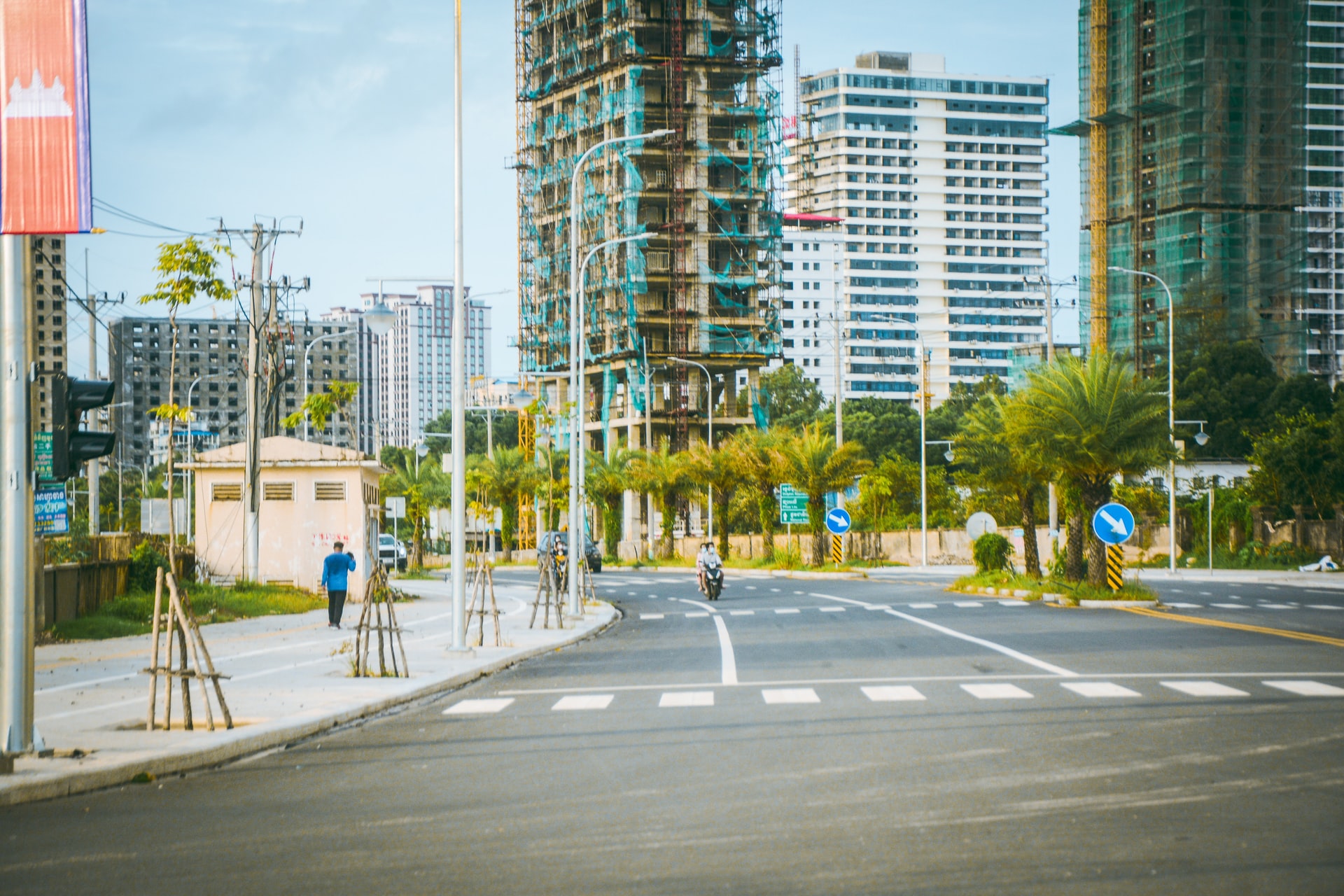
Building in Sihanoukville. Photo by Sim Kimhort via Unsplash.
I. Geopolitical Drivers and Relevant Sectors
Geopolitical drivers
Cambodia is downstream on the Mekong River, creating conflicts of interest regarding water resources. Major players in the region include Vietnam, Thailand, China and the US. According to the National Bank of Cambodia, in 2019, 42% of FDI came from China, followed by South Korea (11%), Vietnam (7%), Japan and Singapore (6% each), as shown in Graph 1.8 Approved FDI over time shows slightly different numbers (See Graph 2), in part due to the fact that approved FDI includes projects that may not come into fruition. See also Tables 1 and 2 in Annex 1, which show that reported amounts of FDI in Cambodia in 2019 vary between USD $3.5 billion and USD $3.7 billion.9
Graph 1: Percentage of FDI Inflow by Nation (2019)
Graph 2: Approved FDI by Country (1994-2019)
China has been Cambodia’s largest investor since 201310 and a key political ally. Since the beginning of China and Cambodia’s current economic relationship in 2006,11 it has become a “comprehensive strategic cooperation partnership” supported by mega-infrastructure projects that are part of the Belt and Road Initiative (BRI).12
In contrast to its global investment,13 China’s investment in Cambodia has increased steadily between 2015 and 2019.14 USD $860 million of Chinese FDI was approved in the first 11 months of 2020.15 China is Cambodia’s largest trade partner with total trade reaching USD $8.53 billion in 2019,16 with a committed bilateral trade volume of USD $10 billion by 2023.17 In addition, Chinese-aided projects are often required to be carried out by Chinese firms.18
Cambodia has not been an attractive destination for US FDI. Nevertheless, some American companies have maintained investments in-country, and the Mekong-US Partnership (2020) promises significant new investment.19 Further, the new US International Development Finance Corporation has promised loans in millions of USD to expand access to financial services.20
Relevant Sectors
FDI in Cambodia is concentrated in construction and real estate, non-garment manufacturing, garment manufacturing, and services. Tourism was previously second highest21, but was gravely affected by the pandemic22. The World Bank reports USD $1.75 billion in total approved investments in 202023, although the first 7 months saw approvals of only USD $25 million24.
The pandemic impacted investment in construction and real estate, but had a minimal impact on non-garment manufacturing.25 See Tables 3-6 in Annex 1 for examples of enterprises that have invested in Cambodia’s top sectors.
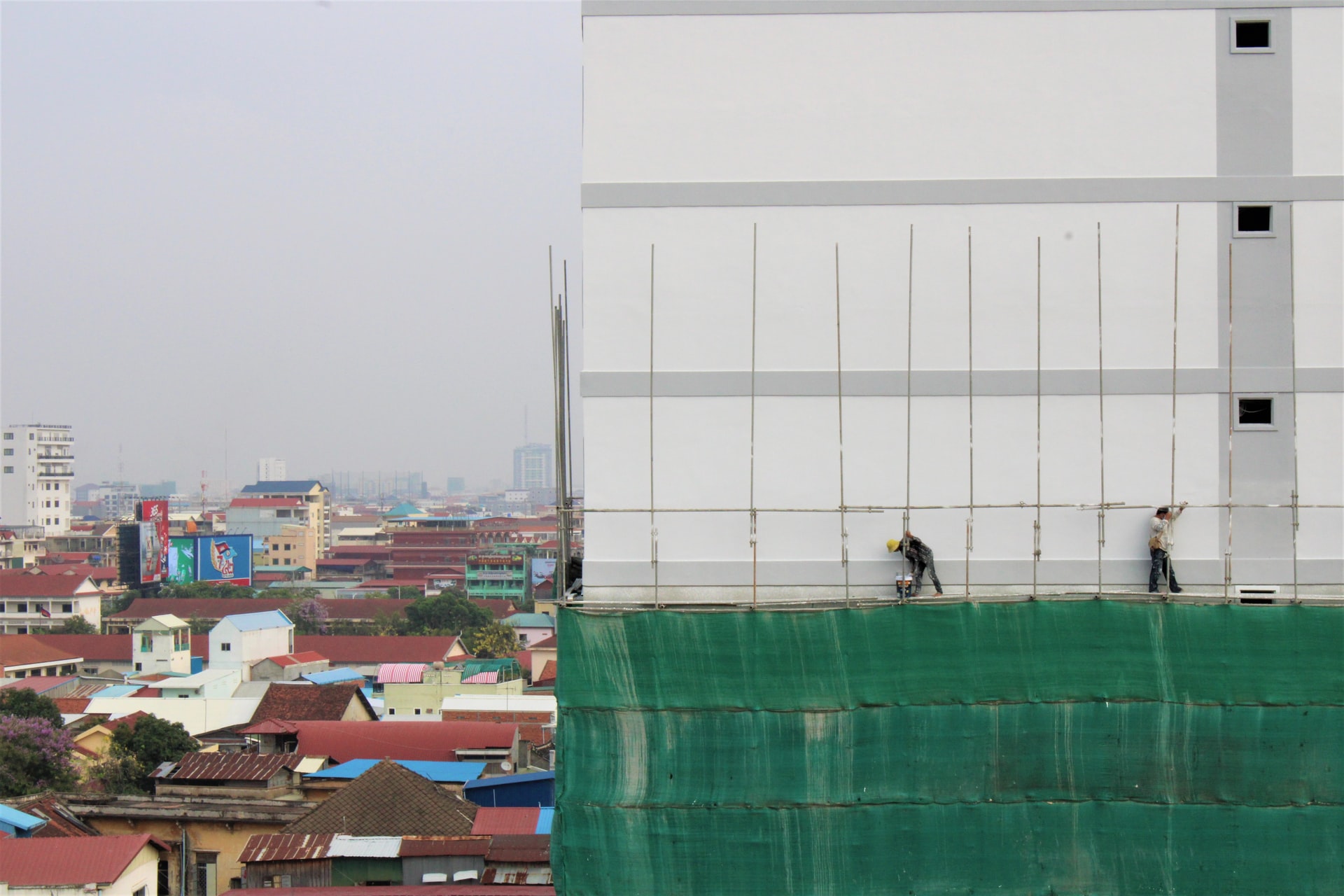
Workers on a building in Phnom Penh. Photo by Jeanne Crump via Unsplash.
II. Legal Framework, Regional, Bilateral Trade Agreements, and Loans
Legal Framework
Overall, Cambodia is an attractive environment for foreign investors. Most sectors are open to foreign ownership through FDI, and the country has a liberal investment regime. This has resulted in many trade agreements as well as foreign loans.
While legal frameworks supporting FDI exist, they remain ambiguous. Additionally, although commercial arbitration is legally available, in practice its availability is limited and there is little information in the public domain on arbitration decisions.26
There are reports that investors lack confidence in the judicial system,27 and so have preferred to resolve commercial disputes through negotiations facilitated by the Ministry of Commerce, the CDC, or the Cambodian Chamber of Commerce.28
1. The Law on Investment (1994, amended 2003); Draft Law on Investment (2021)
Cambodia’s Law on Investment regulates FDI approval and incentivizes “qualified investment projects”29 through tax relief and import duty exemptions.30 It grants all investors the right to freely purchase and remit foreign currencies abroad to discharge their investment-related financial obligations.31 Importantly, the Law guarantees that foreign investments will be generally treated like domestic investments, except that foreign-owned companies may not own land.32 Article 20 provides for dispute resolution.33
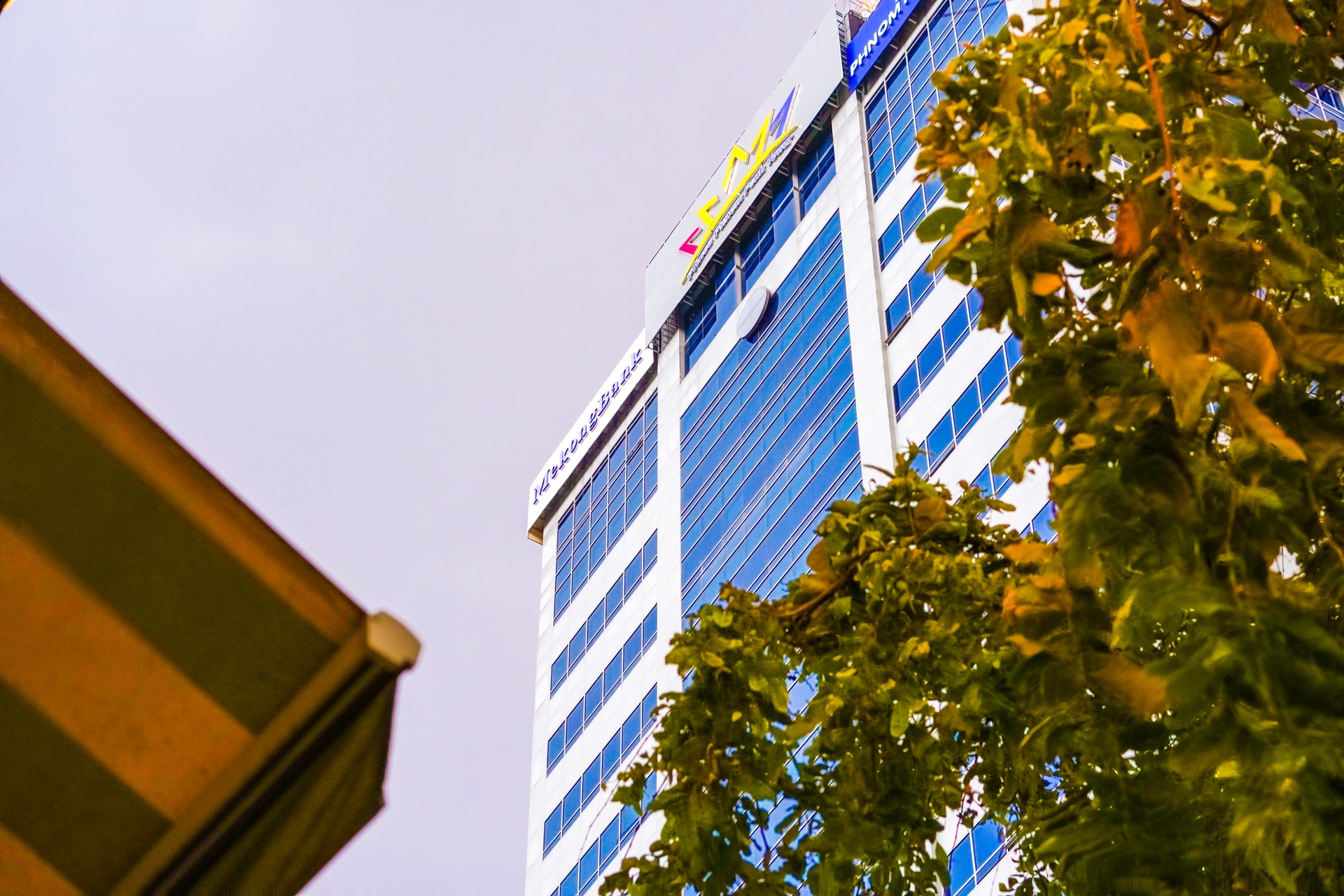
An office building in Phnom Penh. Photo by Vanna Phon via Unsplash.
On October 15, 2021 a new Law on Investment was promulgated.34 It obligates the RGC to protect investment in accordance with international law and is intended to attract investment and enhance economic diversification and competitiveness through both tax and non-tax preferences.35 It envisions simplified registration and monitoring procedures.36
2. International Commercial Arbitration (2006)
The 2006 Law on Commercial Arbitration is modeled on the United Nations Commission on International Trade Law Model Law.37 Since its launch in 2013, the National Arbitration Centre, now called the National Commercial Arbitration Centre (NCAC),38 has administered 27 proceedings worth approximately USD $80 million.39 New procedural rules were adopted on March 28, 2021 to align with international best practices.40
Trade Agreements
1. Protections in Cambodia’s Bilateral Investment Treaties
Cambodia’s Bilateral Investment Treaties (BIT) include internationally understood clauses that are protective of foreign investors. These include fair and equitable treatment, non-discrimination, protection and security, expropriation, and most favoured nation clauses.41 See Table 7 in Annex 1 for a list of relevant clauses.
2. Agreements with China
Cambodia is party to a variety of agreements with China, including the Joint Communique between the Kingdom of Cambodia and the People’s Republic of China (2018)42; the 2020 Cambodia-China FTA (CCFTA)43; and the Regional Comprehensive Economic Partnership (RCEP)44. The CCFTA45 and the RCEP have yet to be ratified by the RGC.
Once ratified, the CCFTA removes tariffs from almost all goods exported and imported between China and Cambodia.46 It also simplifies administrative procedures; introduces clear dispute resolution mechanisms; and fosters e-commerce.47 Cambodia will also reportedly open the services sector to China, including sea transport.48 These measures could increase trade between China and Cambodia by up to 25%,49 and make Cambodia a more attractive FDI destination relative to its neighbors.50
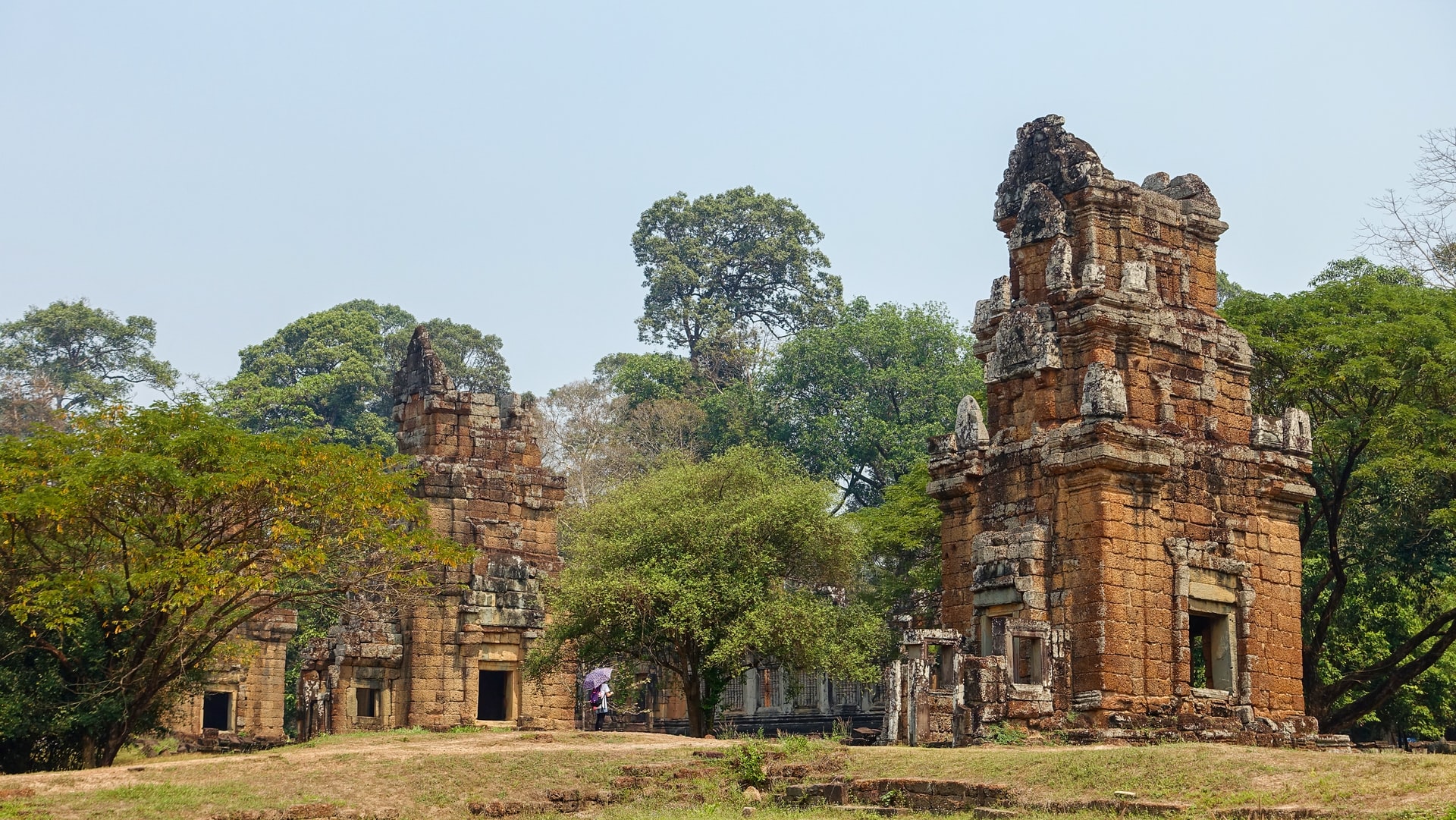
China has provided funding for Cambodia to restore the Angkor Wat complex. Photo by Peter Borter via Unsplash.
The RCEP is intended to support continuing economic integration,51 but experts note that multiple tariff schedules are to be determined, with implementation periods of potentially 20 years as agreed by Cambodia.52 Further, state-owned enterprises are not covered.
3. 2012 ASEAN Comprehensive Investment Agreement (ACIA)
Cambodia is a party to the 2012 ACIA.53 It includes several substantive investment protections commonly found in bilateral investment treaties (BIT).54 It is distinguished from other multilateral investment treaties and FTAs as it is enforceable by an investor-state dispute settlement system or a regional arbitration center.55 Transparency and predictability requirements of the ACIA mean that countries, including Cambodia, may need to undertake sustained regulatory reform.56
Loans
One of the three components of FDI flows is intercompany loans (also known as “FDI debt”).57 FDI debt differs from concessional loans,58 and may only make up a small portion of investment, as is the case for China.59 Chinese financing for a project may be provided through multiple finance arrangements, complicating categorization.60 Table 9 in Annex 1 indicates the types of Chinese financial assistance for development.61
While Prime Minister Hun Sen refers to Chinese foreign assistance as “aid,” both parties include “loans” in “aid”.62 Occasional loan forgiveness, such as the USD $4 million that China forgave Cambodia in 2010, transforms loans into aid, potentially increasing the influence of China over Cambodia until loans are forgiven.63

Loans have financed the development of Cambodia’s infrastructure, including roads. Photo by Sanket Deorukhkar via Unsplash.
Two of China’s three “policy banks”, the China Development Bank and the Export-Import Bank of China (China Eximbank) are active in Cambodia. While most of China Eximbank’s lending is commercial, it has also provided concessional lending for infrastructure projects in Cambodia.64 During 2005-2018, the bank supported over 3,000 km of highways, 430,000 hectares of irrigation, and nearly 8,000 km of transmission lines.65 Recent loans from China Eximbank financed the Transmission Line 230 KV Project Phase II and the National Road No.3 Construction Project.66 Similarly, the China Development Bank loaned US$5.3 billion for 27 projects in Cambodia as of mid-2019.67 In addition, China’s state-owned commercial banks, namely the Industrial and Commercial Bank of China and Bank of China, have significant operations in Cambodia.68,69
III. Relevant Government Policies
1. The National Strategic Development Plan (NSDP) 2019-2023
The National Strategic Development Plan (NSDP) 2019-2023 is intended to help Cambodia to benefit from ASEAN Economic Integration and turn the nation into an Upper-Middle-Income Country by 2030.70 The most relevant for FDI is the provision on the development of the “(2) overarching environment for the implementation of the [Rectangular Strategy Phase IV]”.71 A favorable environment for business and investment will be developed by implementing macroeconomic policies and updating laws; developing mechanisms to deal with potential economic crises and risks; reforming the taxation system; facilitating start-ups; and decreasing administrative complexity.72
2. The 2015–25 Industrial Development Policy (IDP)
The RGC has adopted the Industrial Development Policy (IDP) to help maintain sustainable and inclusive high economic growth through economic diversification, strengthening competitiveness and promoting productivity.73 See Table 10 in Annex 1 for motivations and priority sectors.
3. Special Economic Zones (SEZ)
Cambodia initiated special economic zones (SEZ) in 2005 to facilitate export development, create employment, and promote diversification from traditional sectors.74 Streamlined administrative procedures and high-quality infrastructure and utilities are meant to attract investment.75 There is some uncertainty as to the actual number of SEZs. One report indicated 54 SEZs by 2019,76 but another identified 46 as of September, 2020.77
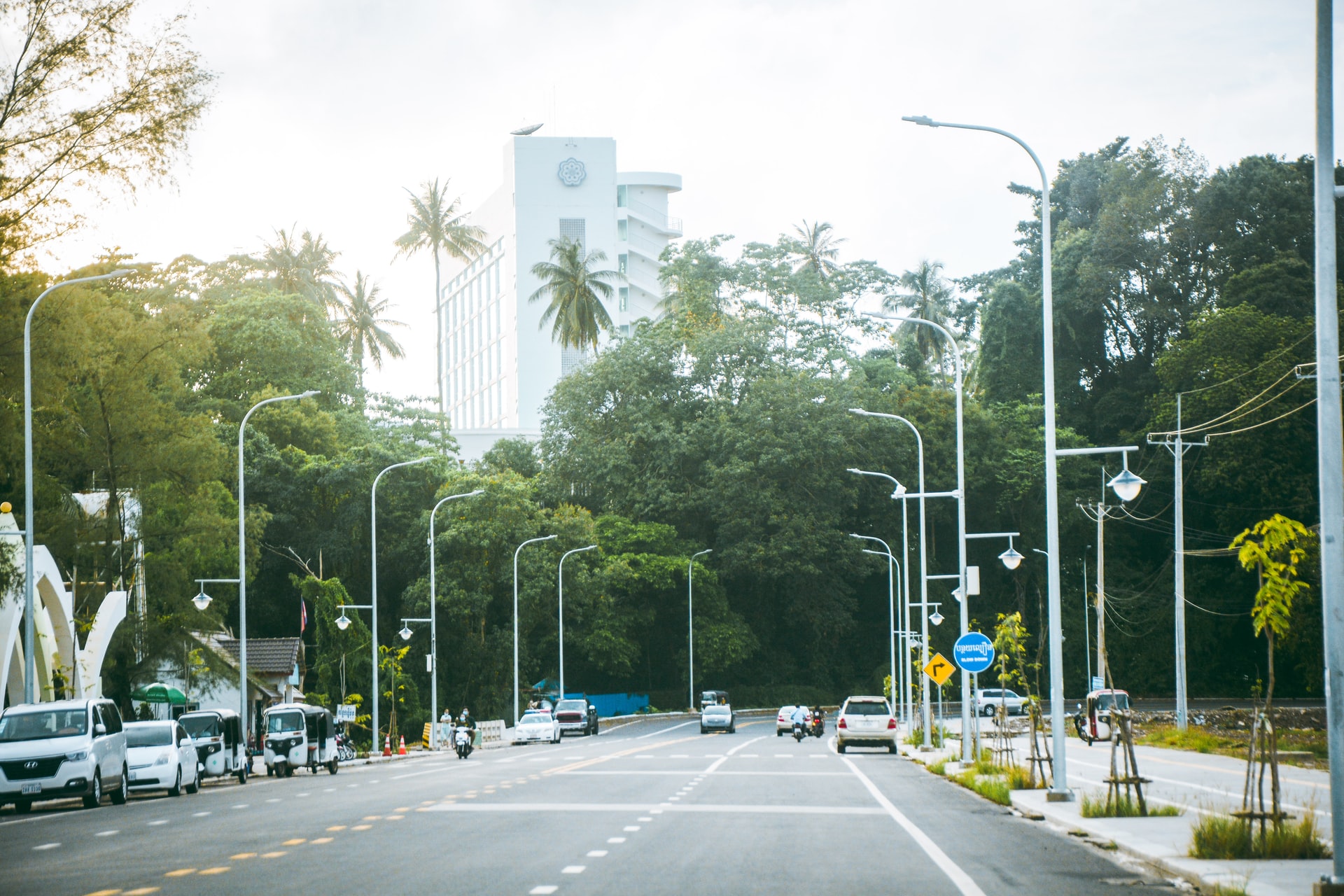
A special economic zone is located in Sihanoukville. Photo via Kim Simhort via Unsplash.
Although SEZs are open to both domestic and foreign firms, almost all firms located in the SEZs are foreign. Most Chinese SEZs are located within the corridor between Phnom Penh, Sihanoukville and Kampot, as well as areas bordering Vietnam in Svay Rieng.78 Between 2005 and 2018, SEZs attracted USD $1.89 billion in FDI,79 and in 2019 alone, exports from SEZs amounted to USD $2.69 billion.80
Cambodia’s SEZ policy has attracted a broader spectrum of foreign investors than outside of SEZs, as well as investors from new countries.81 Similarly, despite the reluctance of American companies to invest in Cambodia, several large American companies have invested more than USD $100 million in the Phnom Penh SEZ, including Coca-Cola.82
The regulatory environment has been cited as a barrier to investment.83 Additionally, while SEZs potentially have spillover benefits, the Cambodian environment needs to be further developed in order to reap these benefits. For example, domestic SMEs may not have the capacity or skill to meet certain international standards, which can deter foreign investors from engaging in business partnerships.84 Economists, environmentalists, and human rights advocates have documented other negative socioeconomic consequences.85
4. 2019–25 Agriculture Sector Development Strategy and (2020-25) Development Plan for Garment and Textiles
The government has developed two plans to develop the Agriculture86 and Garment and Textiles industries.87 Cambodia’s recent suspension from the EU’s Everything But Arms (EBA) initiative stripped the country of its preferential export rights to the EU.88 However, Prime Minister Hun Sen has noted that the COVID pandemic has had the effect of nullifying the impact of this action by the EU.89
A new Agriculture Development Policy 2021-2030 is being developed90 and will guide FDI, among other things.91
5. Roadmap for Tourism (2020-25)
The RGC has drafted a three-stage roadmap (2020–25) to restore and develop the tourism sector.92 However, it is expected that the necessary FDI is unlikely to be sufficiently available.93 Recent approved investment includes USD $150 million to develop 38 roads in Siem Reap, and USD $300 million to build 34 roads in the province of Sihanoukville.94
IV. Economic, Social, and Environmental Consequences
Increasing FDI inflows to Cambodia has driven an increase in GDP, wages, and foreign reserves, as well as a decrease in unemployment and trade deficit.95 However, this investment has also had negative impacts.
1. Illicit Activities
The Kingdom’s economic development has been undercut by illicit activities.96 A region that has been placed under international scrutiny is Sihanoukville.
One issue under close watch is illicit gambling operations.97 After China pledged billions of dollars for infrastructure in Sihanoukville, the gambling industry expanded rapidly. However not all operations were licensed, and this expansion has been observed to be proportional to a spike in criminal activities such as money laundering.98 In August 2019, Cambodia unexpectedly criminalized online gambling, widely seen as a result of Chinese pressure.99 This has decreased the crime rate in Sihanoukville, but has also impacted mostly Chinese FDI inflows.100 Construction projects were stalled or abandoned and reports show widespread failure to pay wages of laborers from both Cambodia and China.101 In addition, reports also reveal that some companies have ignored the online gambling ban.102
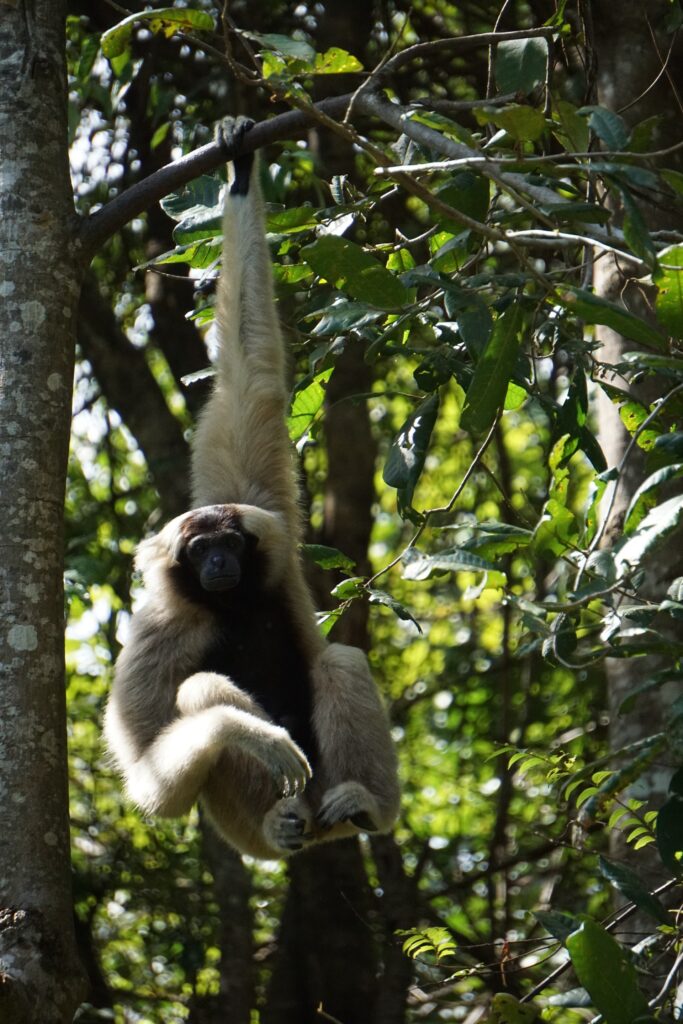
Cambodia’s great biodiversity is impacted by the illegal wildlife trade, but there are sanctuaries where animals like this monkey rescued from illegal trade are rehabilitated. Photo by Slavena Peneva via Unsplash.
The Sihanoukville SEZ is associated with black-market trades in wildlife products,103 including songbirds and reptiles.[Ref]Sarah Heinrich, Joshua V. Ross, Thomas N.E. Gray, Steven Delean, Nick Marx, and Phillip Cassey. 2020. “Plight of the commons: 17 years of wildlife trafficking in Cambodia” in Biological Conservation Volume 241. Accessed July 30, 2021.[/ref],104 This adds to a significant rise in bushmeat poaching in Cambodia, driven by Chinese clientele.105 A turn toward traditional medicine during the COVID-19 pandemic is also considered to have driven an increase in the activity.106,107
2. Environmental Degradation
Cambodian laws tend to prioritize economic development over environmental protection. A 2019 study confirmed that economic development has come at the expense of environmental degradation.108
3. Land Disputes
In its drive to attract foreign investment, Cambodia has awarded Economic Land Concessions (ELCs) to mainly Chinese, Vietnamese and South Korean companies.109 These are long-term leases permitting the development of industrial-scale agriculture.110 However, civic groups note a sharp rise in the number of forced evictions111 and evictions without negotiation or adequate compensation.112 There are ongoing conflicts between investors who hold formal land rights and community members who hold traditional land rights.113 Similarly, poorly monitored ELCs may fail to adhere to their approved plans.114,115 The RGC has suspended the granting of land concessions and is reportedly subjecting existing land concessions to reviews. For examples of disputed regions of Cambodia, see Open Development Cambodia’s land dispute tracker.116
4. Gender Inequality in the Labor Market
Although there is a large body of literature analyzing the effects of FDI on labor market outcomes, there is still little evidence regarding gender effects. Research conducted in 2020 by the Asian Development Bank Institute could not find evidence that FDI helps reduce the gender wage gap in either the garment sector or other manufacturing sectors.117 Nonetheless, a decomposing household survey conducted as part of the research demonstrated that the gender wage gap in formal manufacturing is reduced through FDI, while not in the garment industry, which is the foundation of the economy and employs mostly women.118
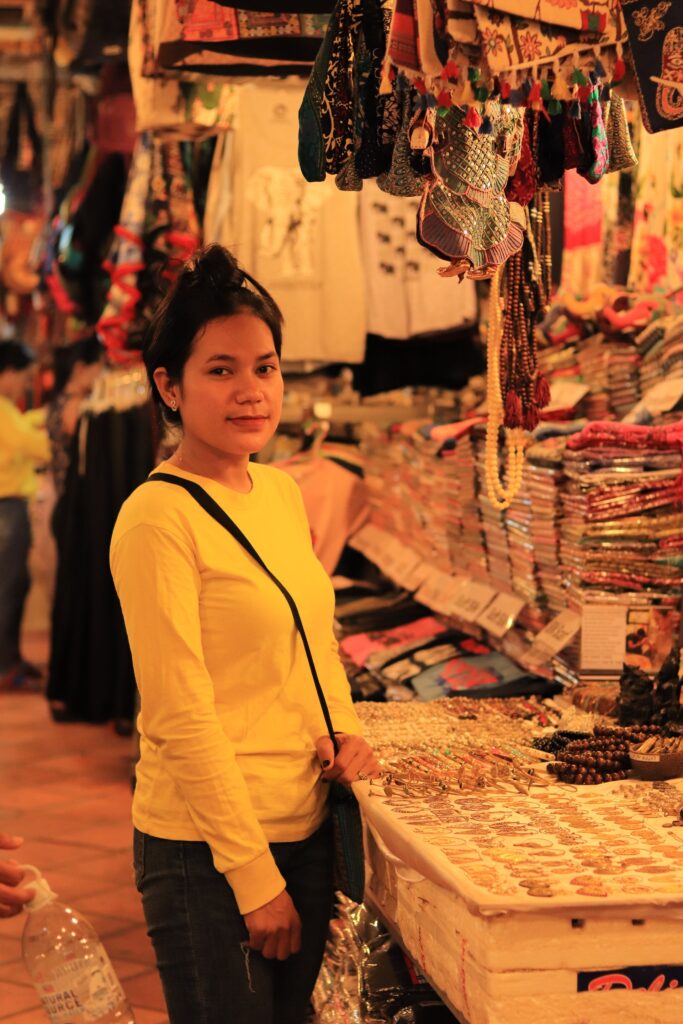
Women commonly work in the garment industry, whether in the factories or selling at markets. Photo by Chetan Hireholi.
V. Recommendations
While the RGC has entered into FDI agreements that have and are likely to continue to economically benefit Cambodia, the sustainability of these benefits, the implementation of some aspects of agreements, and the reach of the benefits across all sectors of society are areas that would benefit from further consideration. The following recommendations have this in mind.
1. Progress on policy development and agreement ratification and implementation should be tracked
Cambodia is undergoing a number of legal changes that have an impact on FDI, and a number of agreements have yet to be ratified. Arising from these as-yet to be implemented documents are legally binding responsibilities to determine tariff schedules such as in the RCEP, and streamline administrative procedures such as in the Draft Investment Law, among other things. Tracking ratification, then the development of the related documents and shifts in regulatory procedure, as well as whether changes are in accordance with international law as indicated by the relevant law or agreement, would support the development of a transparent, easily understandable investing environment.
Something of note is that Cambodia may face revenue loss under RCEP amounting to 1.24% of the country’s 2019 GDP, or USD $270 million.119,120 Tracking actual versus projected economic loss and benefit will support a clearer understanding of the impacts of such investment agreements, while also creating a stronger evidentiary base from which interested parties can draw upon when advocating for policy change and greater accountability.
Another related recommendation for tracking is of the implementation of already-agreed clauses in agreements as well as requirements in law. Some agreements, such as the ACIA, may require regulatory reform to meet the requirements of the agreement. Tracking the efforts of the RGC in implementation increases accountability and transparency.
2. Conduct research on the impact of FDI on gender
While there is an understanding that women’s participation in the labour market varies by sector, the impact of FDI involvement in particular sectors, and whether and how women benefit from the associated economic incentives and opportunities, remains an area to be studied. Without understanding such impacts on women, inclusive and sustainable development will remain unattainable. Thus, understanding the impacts of FDI on gender will help to promote Cambodia’s efforts in this regard.
3. Conduct study to identify barriers to positive spillover effects in Special Economic Zones
Special Economic Zones are well-established in Cambodia, but the oft-cited positive spillover effects have generally remained elusive due to gaps in capacity and education, as well as the difficulty for domestic small and medium enterprises (SMEs) to meet regulatory requirements, among other things. Action-oriented research to first understand the needs of and barriers experienced by both individuals and SMEs to take advantage of the benefits of SEZs, then identifying and implementing actions to meet these needs and bridge barriers would go a long way to encouraging the benefits of SEZs to come to fruition while also encouraging foreign investors to engage in business partnerships with domestic enterprises and individuals.
4. Corporate investor mapping to support advocacy in land and environmental issues
Advocacy in land and environment issues is strong in Cambodia. However, as it relates to FDI, advocacy is complicated, as corporate social responsibility remains optional, and reporting on ultimate corporate control of enterprises is not yet required. In this regard, ensuring the correct entity is responsible is difficult. Thus, corporate investor mapping, and opening this data, would be beneficial to support ongoing efforts in land and environment.
5. Illicit gambling – monitoring and documentation of activities
The rise of illicit gambling and associated illegal activities is an issue of concern in areas with high levels of FDI from China, such as Sihanoukville. Some documentation and investigation of these activities have occurred, but these activities continue and the depth of potential harm to both Chinese and Cambodian nationals is not yet understood. Continued independent monitoring of these activities, supported by systematic documentation, would be a strong first step in addressing the issue.
Annex 1
Table 1: Changes in FDI in Cambodia (2018-2019)121
|
Foreign Direct Investment |
2018 |
2019 |
|
FDI Inflow (USD $ million) |
3,208 |
3,706 |
|
FDI Stock (USD $ million) |
30,369.9 |
34,030.3 |
Source: UNCTAD – Latest available data
Table 2: Changes in Approved FDI by Sectors (2017-2020, in USD $ Million)122
|
Year |
Agriculture |
Services |
Tourism |
Energy |
Other Industries |
|
2017 |
274.5 |
1,049.5 |
3,166.6 |
– |
726.3 |
|
2018 |
444.2 |
2,869.9 |
1,577.8 |
– |
984.0 |
|
2019 |
68.7 |
1,028.3 |
6,051.6 |
158.6 |
859.4 |
|
2020 (up to Q3) |
94.2 |
790.2 |
3,850.5 |
321.9 |
809.3 |
Source: Council for the Development of Cambodia (National bank of Cambodia Economic & Monetary Statistics, Oct 2020)
Table 3: Examples of Foreign Companies Investing in Cambodia’s Construction Sector
|
Company |
Origin |
Year Established |
Description |
|
Sumitomo Electric Industries |
Japan |
2018 |
High-voltage underground cables for transmission and distribution of electricity |
|
Hanshin Construction |
Republic of Korea |
2018 |
Repair and expansion of roads |
|
Nokia |
Finland |
2018 |
High-speed broadband service |
|
Guangdong Provincial Changda Highway Engineering |
China |
2019 |
Road maintenance and upgrade |
|
Toshiba |
Japan |
2019 |
150 MW power station construction |
|
TPSC Engineering |
Malaysia |
2019 |
Subsidiary of Toshiba for the power station construction |
|
TPSC Engineering |
Thailand |
2019 |
Subsidiary of Toshiba for the power station construction |
|
General Electric |
United States |
2019 |
Supply and equipment for a 35 MW coal-fired power plant |
|
Toshiba Plant System & Services Corporation |
Japan |
2019 |
Supply and equipment for a 35 MW coal-fired power plant |
|
Sinomach |
China |
2019 |
Operation of 28 engineering project, including a power station project |
Table 4: Examples of Foreign Companies Investing in Cambodia’s Non-garment Sector
|
Company |
Origin |
Year Established |
Description |
|
Okato |
Japan |
2018 |
Manufacturing plant in Phnom Penh SEZ |
|
Sumitronics |
Japan |
2018 |
Electronics |
|
Denso |
Japan |
2018 |
Automotive parts |
|
Toyota Tsusho Corporation |
Japan |
2018 |
Automotive parts, further business development and marketing |
|
Kampot Cement |
Thailand |
2018 |
Constructed a third cement plant |
|
Zuelig Pharma |
Hong Kong |
2018 |
Partnership with Fresenuius for expansion |
|
Fresenuius Medical Care |
Germany |
2018 |
Partnership with Zuelig for expansion |
|
DKSH Holding |
Switzerland |
2018 |
Acquired Europ Continents, medical equipment producer |
|
Socfin |
Luxembourg |
2018 |
Rubber processing factory |
|
Green Leader Holdings Group |
Hong Kong |
2018 |
Sassava processing facility |
|
Conch International Holdings |
China |
2018 |
Cement factory |
|
Walita Toys |
China |
2018 |
Toy factory |
|
Winsun |
Taiwan |
2018 |
Manufacturing facility |
|
Midori Techno Park Corporation |
Japan |
2018 |
Manufacturing space for eco-friendly clients |
|
BASF |
Germany |
2019 |
Chemical manufacturer |
|
Minebea |
Japan |
2019 |
Machinery components and electronic devices |
|
Yamato Printing |
Japan |
2019 |
Stationary products |
Table 5: Examples of Foreign Companies Investing in Cambodia’s Garment Sector
|
Company |
Origin |
Year Established |
Description |
|
Bagsac Hong Kong Co Ltd |
Hong Kong |
2018 |
Handbag, wallet factory |
|
Sansho Clothing Co, Ltd |
Japan |
2018 |
Dress factory |
|
JS Leather Collection Phnom Penh Co, Ltd |
Republic of Korea |
2018 |
Bagm handbag factory |
|
Seo Rim Co, Ltd |
Republic of Korea |
2019 |
T-shirt, sweater, robe, pants factory |
|
Qins Textile Co, Ltd |
Republic of Korea |
2019 |
T-shirt, skirt, pants factory |
|
De Xiang Garment Co, Ltd |
China |
2019 |
Hat, blanket, laundry bag, cap, napkin factory |
|
Eucloth International Garment Co, Ltd |
China |
2019 |
T-shirt factory |
|
Qingdao Roy Ne Garment Co, Ltd |
China |
2019 |
T-shirt, underwear factory |
|
Fashiontex Apparel Co, Ltd |
China |
2019 |
T-shirt, trouser factory |
|
GG Fashion Co, Ltd |
Singapore |
2019 |
Jacket, pants, shirt factory |
|
Shenzhou International Group Holdings |
China |
2019 |
Garment factory (to be completed in 2021) |
Table 6: Examples of Foreign Companies Investing in Cambodia’s Services Sector
|
Company |
Origin |
Year Established |
Description |
|
Jacobs Douwe Egberts |
Netherlands |
2018 |
Acquired operations of Oldtown White Coffee (Malaysian) |
|
Aeon |
Japan |
2018 |
Malls |
|
Isuzu |
Japan |
2018 |
Showrooms for marketing and distribution business |
|
Furla |
Italy |
2018 |
Luxury goods boutique in partnership with China Duty Free Group |
|
Circle K |
Canada |
2018 |
Retail company |
|
Decathlon Group |
France |
2018 |
Sportswear retail |
|
Tokyo Hotel Apartments & Spa |
Japan |
2018 |
Hotel |
|
TGG Takara Gaming Group |
Hong Kong |
2018 |
Gaming |
|
Dai-ichi Life Holdings |
Japan |
2018 |
Life insurance |
|
ABA Bank |
Canada |
2018 |
Bank |
|
Shinhan Bank |
Republic of Korea |
2018 |
Bank |
|
Taiwan Cooperative Bank |
Taiwan |
2018 |
Bank |
|
Industrial Bank of Korea |
Republic of Korea |
2018 |
Bank |
|
Unionpay |
China |
2018 |
Digital payment system |
|
Alipay |
China |
2018 |
Fintech: mobile banking services |
|
World Remit |
United Kingdom |
2019 |
Fintech: mobile banking services |
|
Evergreen Marine Corporation |
Taiwan |
2019 |
Shipping and logistics |
|
Nippon Express |
Japan |
2019 |
Shipping and logistics |
|
Oji Group |
Japan |
2019 |
Packaging company |
|
Marko |
Germany |
2019 |
Retail company (supermarket) |
Table 7: Clauses in Cambodia’s Bilateral Investment Treaties
|
Clause |
Description/Example |
|
Fair and Equitable Treatment |
“Investments of investors of either Contracting Party shall at all times be accorded fair and equitable treatment and shall enjoy adequate protection and security in the territory of the other Contracting Party.” (Cambodia-Indonesia BIT) |
|
Non-Discrimination |
“Each Contracting Party shall ensure fair and equitable treatment of the investments of investors of the other Contracting Party and shall not impair, by unreasonable or discriminatory measures, the operation, management, maintenance, use, enjoyment or disposal thereof by those investors.” (Cambodia-Indonesia BIT) |
|
Protection and Security |
● “Full protection and security” (Cambodia- Croatia, Czech Republic, Germany, Japan, Korea, Malaysia, Pakistan, and Thailand BITs) ● “Full physical security and protection” (Cambodia-Netherlands BIT) ● “Adequate protection and security” or “Adequate physical security and protection” (Cambodia-Indonesia, Cuba, Vietnam and the Philippines BITs) |
|
Expropriation |
All publicly available Cambodian BITs prohibit the expropriation, nationalization and any other equivalent measure by the RGC, unless the measure taken by the host State: (1) serves a public purpose; (2) is taken under due process of law and/or in accordance with domestic legal procedure; (3) without discrimination; and (4) on payment of compensation. |
|
Most Favored Nation |
The treatment of investments from other Contracting States to be no less favorable than that granted to nationals of third states. |
|
National Treatment |
This obliges parties to provide treatment not less favorable than what it provides to domestic investors. |
Table 8: Selected agreements from 2018 Joint Communique between Cambodia and PRC
|
The Chinese Side Will: |
Both Sides Will: |
|
● Organize trade promotion activities and expand import from Cambodia ● Welcome more Cambodian agricultural products that meet both Chinese inspection and quarantine standards and consumer needs ● Continue to assist Cambodia in such development areas as transportation, water conservancy, demining, education and medical service ● Continue to provide more scholarships and technical training ● Continue to provide assistance to the conservation and restoration of ancient Angkor heritage, the Preah Vihear Temple and other cultural complexes in Cambodia |
● Advance the implementation of the Memorandum of Understanding on Strengthening Infrastructure Cooperation ● Support companies with high capability and credibility in strengthening cooperation in key fields such as infrastructure, agriculture, water and energy resources, telecommunication, industry and tourism ● Actively support counterpart friendship associations and institutions, think-tanks, media and NGOs to play a bigger role in promoting people-to-people exchanges ● Forward agricultural cooperation ● Promote the construction of Sihanoukville SEZ and projects such as the Phnom Penh-Sihanoukville Expressway and the new airport in Siem Reap |
Table 9: Types of Chinese Financial Assistance for Development
|
Type of Assistance |
Description |
|
Grant or “Donation” |
Mostly used to help the recipient country government construct social welfare projects such as hospitals, schools, and housing. They are also used to provide goods and materials and emergency humanitarian disaster relief aid, and to train personnel. |
|
Interest-free Loan |
Usually provided when recipient countries want to build a “turnkey” project. When China forgives debt, it is often for this type of loan. But these types of interest-free loans can also be provided for other types of projects. |
|
Concessional Loan |
Concessional loans carry interest, but at “low” rates. They usually have a grace period of at least two years, and repayments can stretch over 10 or even 20 years. These loans tend to be provided for big infrastructure projects, and they are provided directly by the Export–Import Bank of China (EximBank). |
|
South-South Cooperation Assistance Fund |
Fund created by China to assist technical cooperation among developing countries in the Global South.123 |
Table 10: The Industrial Development Policy (2015-25)124
|
Motivation |
Priority Sectors |
|
1) To promote the favorable geopolitical spillovers by linking Cambodian economy within the ASEAN Economic Community and regional economic liberalization frameworks; 2) Potential of industrial sector in accelerating growth and creating new jobs in an open economy; 3) Industrial sector’s role as a policy tool to enhance the performance of core economic sectors (i.e. agriculture and services); 4) To initiate structural and governance reforms of key national economic institutions, which will boost economic productivity and help avoid falling into the “middle income trap.”
|
1) New industries with the capability of breaking into new markets with high value-added products; 2) SMEs in all sectors; 3) Agro-industrial production; 4) Industries that support the agriculture, tourism and textile sectors and regional production chains; and 5) Industries serving regional production lines that are of future strategic importance including information technology and telecommunication (ICT) and energy. |
References
- 1. GDP change per year.
- 2. The World Bank. 2021. The World Bank in Cambodia: Overview. Accessed June 8, 2021.
- 3. The Stimson Center. 2012. Cambodia Country Profile. Accessed June 8, 2021.
- 4. The World Bank and the International Monetary Fund (“IMF”) define FDI as “the net inflows of investment to acquire a lasting management interest (10% or more of voting stock) in an enterprise operating in an economy other than that of the investor.” The World Bank. 2021. Metadata Glossary. Accessed June 10, 2021. However, because Cambodia’s top investment approval body, the Council for Development of Cambodia (CDC), reports approved investment, which includes projects that might never be implemented, reported numbers of FDI vary depending on the source. Ministry of Commerce. 2014. Cambodia Trade Integration Strategy 2014-2018. Accessed June 10, 2021. See examples in Annex 1.
- 5. Seng Sothan. 2017. “Causality between foreign direct investment and economic growth for Cambodia” in Cogent Economics & Finance Vol. 5:1. DOI 10.1080/23322039.2016.1277860. Accessed June 10, 2021.
- 6. Ibid.
- 7. The World Bank. 2021. Cambodia Economic Update: Road to Recovery. Accessed June 23, 2021.
- 8. The Phnom Penh Post. 2021. FDI Inflows Drop 1% to $3.5B. Accessed July 5, 2021.
- 9. UNCTAD. 2020. World Investment Report 2020. Accessed June 9, 2021.
- 10. The Council for Development of Cambodia. 2020. FDI Trend. Accessed June 11, 2021.
- 11. China Daily. 2006. China Pledges $600 Million to Cambodia. Accessed June 11, 2021.
- 12. The Konrad Adenauer Foundation. 2020. Cambodia-China Relations in the New Decade. Accessed June 11, 2021.
- 13. The World Bank. 2021. Foreign Direct Investment, Net Outflows (% of GDP) – China. Accessed June 16, 2021.
- 14. The Phnom Penh Post. 2019. China Still No 1 Source of FDI. Accessed June 16, 2021.
- 15. The Phnom Penh Post. 2021. China FDI Hits $860M in First 11 Months of 2020. Accessed June 14, 2021. Note that this number may be different from those provided by intergovernmental organizations since China’s New Law on Foreign Investment introduces several inconsistencies as to what comprises FDI. See China Briefing. 2019. How to Read China’s New Law on Foreign Investment. Accessed August 2, 2021.
- 16. Xinhua. 2020. 中国驻柬商务参赞:中柬经贸合作2019年成果丰硕. Accessed June 15, 2021.
- 17. Kingdom of Cambodia & the People’s Republic of China. 2019. Joint Communique Between the Kingdom of Cambodia and the People’s Republic of China. Accessed June 15, 2021.
- 18. Daniel O’Neil. 2014. “Playing Risk: Chinese Foreign Direct Investment in Cambodia” in Contemporary South East Asia Vol. 36:2. DOI 10.1355. Accessed June 12, 2021.
- 19. US Embassy in Cambodia. 2020. Launch of the Mekong-US Partnership: Expanding US Engagement with the Mekong Region. Accessed June 16, 2020.
- 20. US International Development Finance Corporation. 2020. DFC Approves $3.6 Billion of New Investments in Global Development in Largest Quarter Ever. Accessed August 5, 2021.
- 21. UNDP. 2021. Cambodia’s Development Finance Assessment. Accessed July 18. 2021.
- 22. The World Bank. 2021. Cambodia Economic Update: Road to Recovery. Accessed June 23, 2021.
- 23. Ibid.
- 24. The World Bank. 2020. Cambodia Economic Update: Restrained Recovery. Accessed June 23, 2021. Note that USD $1.49 billion of FDI in tourism is reported to have been approved in the last five months of 2021, but without further details it is unclear as to what contributed to this jump in figures.
- 25. World Construction Today. 2021. Growth to Slow Down in Cambodian Construction Industry Due to Tourism and Foreign Investment Decline. Accessed July 21, 2021.
- 26. Romesh Weeramantry. 2017. “International Investment Law and Practice in Cambodia” in Journal of World Investment & Trade 18. Accessed June 10, 2021.
- 27. US Department of State. 2020. 2020 Investment Climate Statements: Cambodia. Accessed June 10, 2021.
- 28. Ibid.
- 29. Regulated under the Sub-decree No. 111 on the Implementation of the Law on Investment, 2005, as amended in 2007 and 2019.
- 30. Royal Government of Cambodia. 1994. The Law on Investment, Article 12-15.
- 31. Royal Government of Cambodia. 1994. The Law on Investment, Article 11.
- 32. Royal Government of Cambodia. 1994. The Law on Investment, Article 8: “A foreign investor shall not be treated in any discriminatory way by reason only of the investor being a foreign investor, except in respect of ownership of land as set forth in the Land Law.”
- 33. Royal Government of Cambodia. 1994. The Law on Investment, Article 10.
- 34. DFDL. 2021. Cambodia: Promulgation of the Law on Investment. Accessed January 11, 2022.
- 35. Ibid.
- 36. Khmer Times. 2021. Cambodia’s New Investment Law Becomes More Attractive and Considerate for Investors. Accessed July 26. 2021.
- 37. BNG Legal. 2017. Commercial Arbitration in Cambodia. Accessed July 15, 2021.
- 38. Romesh Weeramantry. 2017. “International Investment Law and Practice in Cambodia” in Journal of World Investment & Trade 18. Accessed June 10, 2021.
- 39. Khmer Times. 2021. New Commercial Arbitration Rules Enter Into Force. Accessed July 26, 2021.
- 40. SokSiphana & Associates. 2021. Commercial Arbitration in Cambodia: The New NCAC Rules 2021 Are Out Now. Accessed July 26, 2021.
- 41. Loretta Malintoppi and Chris Tan. 2017. “Cambodia’s Bilateral Investment Treaties” in Investment Protections in Southeast Asia: a Country-by-country Guide on Arbitration Laws and Bilateral Investment Treaties. pp 93-99. Brill Nijhoff. Accessed July 6, 2021.
- 42. Office of the Council of Ministers. 2018. Joint Communique Between the Kingdom of Cambodia and the People’s Republic of China. Accessed July 11, 2021. In January 2018, Cambodia reached consensus with China on a number of bilateral, regional, and international issues, including those in Table 8 in Annex 1.
- 43. ASEAN Briefing. 2020. The China-Cambodia FTA to Become Cambodia’s First Bilateral Free Trade Agreement. Accessed July 11, 2021.
- 44. World Economic Forum. 2021. An Expert Explains: What is RCEP, the World’s Biggest Trade Deal? Accessed July 13, 2021.
- 45. Phnom Penh Post. 2021. Ratification of FTA with China in Sight. Accessed July 15, 2021.
- 46. Ibid.
- 47. China Daily. 2020. China, Cambodia Sign FTA. Accessed July 10, 2021.
- 48. The World Bank. 2020. Cambodia Economic Update: Restrained Recovery. Accessed June 23, 2021.
- 49. Ibid.
- 50. Ibid.
- 51. Ibid.
- 52. The Phnom Penh Post. 2021. Cambodia, ASEAN Likely to Teeter Off Balance with RCEP. Accessed July 13, 2021.
- 53. ASEAN. 2012. ASEAN Comprehensive Investment Agreement (ACIA) Enters Into Force Creating a Stable and Predictable Business Investment Environment. Accessed July 11, 2021.
- 54. Such as the standards of national treatment and most-favored-nation treatment.
- 55. Ibid.
- 56. ASEAN Secretariat. 2013. ASEAN Comprehensive Investment Agreement. Accessed July 5, 2021.
- 57. OECD. 2010. Measuring Globalisation: OECD Economic Globalisation Indicators 2010. Accessed July 25, 2021.
- 58. UNCTAD. 2004. External Finance, Debt and Foreign Direct Investment. Accessed July 25, 2021.
- 59. Radio Free Asia. 2021. Transparency of Chinese Loans. Accessed July 26, 2021.
- 60. Ibid.
- 61. Center for Global Development. 2020. China’s Foreign Aid: A Primer for Recipient Countries, Donors, and Aid Providers. Accessed July 25, 2021.
- 62. Daniel O’Neill. 2014. “Playing Risk: Chinese Foreign Direct Investment in Cambodia” in Contemporary South East Asia Vol. 36:2. DOI 10.1355. Accessed June 12, 2021.
- 63. Ibid.
- 64. Inclusive Development International. 2020. Reassessing China’s Investment Footprint in Cambodia. Accessed June 15, 2021.
- 65. Ibid.
- 66. YiCai Global. 2018. Export-Import bank of China Has Funded 3,000 Km of Cambodian Roads. Accessed July 20, 2021.
- 67. Cambodia Constructors Association. 2019. Over US$5 Billion in Infrastructure Loans Granted to Cambodia. Accessed July 20, 2021.
- 68. China Development. 2019. 访中国银行金边分行行长陈长江. Accessed July 14, 2021.
- 69. Bank of China. 2017. 中行金边分行7年累计支持百余客户逾20亿美元贷款. Accessed July 14, 2021.
- 70. Royal Government of Cambodia. 2019. The National Strategic Development Plan. Accessed July 6, 2021.
- 71. Ibid.
- 72. Ibid.
- 73. Open Development Cambodia. 2015. Cambodia Industrial Development Policy. Accessed July 10, 2021.
- 74. According to the CDC, “Sub-Decree No.147 on the Organization and Functioning of the CDC” was issued on 29 December 2005 to restructure the organization of the CDC and establish a new wing called the “Cambodian Special Economic Zone Board (CSEZB).” On the same day, the RGC issued “Sub-Decree No. 148 on the Establishment and Management of the Special Economic Zone” (the SEZ Sub-Decree) to govern the SEZ scheme. A draft “Law on the Special Economic Zones” has been in process since 2008.
- 75. Council for the Development of Cambodia. 2021. The Special Economic Zones. Accessed July 23, 2021.
- 76. Khmer Times. 2020. Cambodia Has 54 Special Economic Zones, More to Come. Accessed July 19, 2021.
- 77. Open Development Cambodia. 2020. Special Economic Zones. Accessed July 22, 2021.
- 78. Inclusive Development International. 2020. Reassessing China’s Investment Footprint in Cambodia. Accessed June 15, 2021.
- 79. UNDP. 2018. Development Finance Assessment Snapshot: Cambodia. Accessed July 23, 2021.
- 80. Khmer Times. 2020. Cambodia Has 54 Special Economic Zones, More to Come. Accessed July 19, 2021.
- 81. OECD. 2018. Investment Policy Reviews: Cambodia. Accessed June 20, 2021.
- 82. Ibid.
- 83. Peter Warr and Jayant Menon. 2015. Cambodia’s Special Economic Zones. Accessed July 15, 2021.
- 84. OECD. 2018. Investment Policy Reviews: Cambodia. Accessed June 20, 2021.
- 85. IMF. 2020. The Socio-Economic Impact of Special Economic Zones: Evidence from Cambodia. Accessed July 30, 2021; Focus on the Global South. 2017. SEZs and Value Extraction from the Mekong. Accessed July 30, 2021.
- 86. Food and Agriculture Organization of the United Nations. 2021. A New Development Policy is in Place for Agriculture: Strong Prospects for the Sector in the Next 10 Years. Accessed July 15, 2021.
- 87. Khmer Times. 2020. Ministry Releases Five-year Plan for Garment and Textile Sector. Accessed July 21, 2021.
- 88. Ecotextile. 2020. Cambodia Sets Out Five-year Development Strategy. Accessed July 21, 2021.
- 89. Niem Chheng and Ry Sochan. 2021. COVID Nullified impact of EBA withdrawal, PM says. Accessed November 16, 2021.
- 90. Food and Agriculture Organization of the United Nations. 2021. A New Development Policy is in Place for Agriculture: Strong Prospects for the Sector in the Next 10 Years. Accessed July 15, 2021.
- 91. Ibid.
- 92. The Phnom Penh Post. 2020. Tourism Recovery Roadmap Drafted. Accessed July 19, 2021.
- 93. The World Bank. 2020. Cambodia Economic Update: Restrained Recovery. Accessed June 23, 2021.
- 94. Ibid.
- 95. World Bank. 2018. Cambodia Economic Update: Recent Economic Developments and Outlook. Accessed July 6, 2021.
- 96. Radio Free Asia. 2021. Mekong River Region Economic Zones Draw Illegal Actors. Accessed July 29, 2021.
- 97. Inclusive Development International. 2020. Reassessing China’s Investment Footprint in Cambodia. Accessed June 15, 2021.
- 98. Ibid.
- 99. Radio Free Asia. 2021. Mekong River Region Economic Zones Draw Illegal Actors. Accessed July 29, 2021.
- 100. Ibid.
- 101. Ibid.
- 102. Ibid.
- 103. Mongabay. 2021. Chinese Special Economic Zones Hotspots for Wildlife Trafficking, Survey Says. Accessed July 28, 2021.
- 104. Ibid.
- 105. Mongabay. 2021. Wildlife Trafficking, Like Everything Else, Has Gone Online During COVID-19. Accessed July 28, 2021.
- 106. Foreign Policy. 2021. Endangered Species Are Paying the Price of COVID-19. Accessed July 29, 2021.
- 107. National Geographic. 2020. China Promotes Bear Bile as Coronavirus Treatment, Alarming Wildlife Advocates. Accessed July 29, 2021.
- 108. Anh Hoang To, Dao Thi-Thieu Ha, Ha Minh Nguyen, and Duc Hong Vo. 2019. “The Impact of Foreign Direct Investment on Environmental Degradation: Evidence from Emerging Markets in Asia” in International Journal of Environmental Research and Public Health. 16(9):1636. DOI 10.3390/ijerph16091636. Accessed July 20, 2021.
- 109. Reuters. 2010. Aid Donors Urged to Get Touch on Cambodia Over Land. Accessed July 23, 2021.
- 110. Open Development Cambodia. 2015. Concessions. Accessed August 1, 2021.
- 111. Witness. (No date). Combating Forced Evictions in Cambodia. Accessed July 24, 2021.
- 112. Chi Mgbako, Rijie Ernie Gao, Elizabeth Joynes, Anna Cave, and Jessica Mikhailevich. 2010. “Forced Eviction and Resettlement in Cambodia: Case Studies from Phnom Penh” in Washington University Global Studies Law Review. Volume 9 Issue 1. Accessed July 24, 2021.
- 113. NGO Forum of Cambodia. 2015. Statistical Analysis of Land Disputes in Cambodia. Accessed July 20, 2021.
- 114. Sarah Milne. 2015. “Illicit Logging in the Shadow of Transnational Governance and Investment” in Critical Asian Studies. Vol. 47:2. DOI 10.1080. Accessed July 22, 2021.
- 115. Xi Jiao et al. University of Copenhagen. 2015. Rural Household Incomes and Land Grabbing in Cambodia. Accessed July 22, 2021.
- 116. Open Development Cambodia. 2021. Land Dispute. Accessed July 27, 2021.
- 117. Asian Development Bank Institute. 2020. Do Women Benefit From FDI? FDI and Labor Market Outcomes in Cambodia. Accessed August 3, 2021.
- 118. Ibid.
- 119. UNCTAD. 2020. Global Investment Trends Monitor, Special Issue: RCEP Agreement. Accessed July 13, 2021.
- 120. The Phnom Penh Post. 2021. Cambodia’s Trade Deficit to Worsen to $2.3B Per Year with RCEP, Says UNCTAD Expert. Accessed July 13, 2021.
- 121. UNCTAD. 2020. World Investment Report 2020. Accessed June 9. 2021.
- 122. The National Bank of Cambodia. 2019. Macroeconomic and Banking Sector Developments in 2019 and Outlook for 2020. Accessed July 5, 2021.
- 123. The United Nations. 2019. What is ‘South-South Cooperation’ and Why Does It Matter? Accessed July 26, 2021.
- 124. Ibid.

